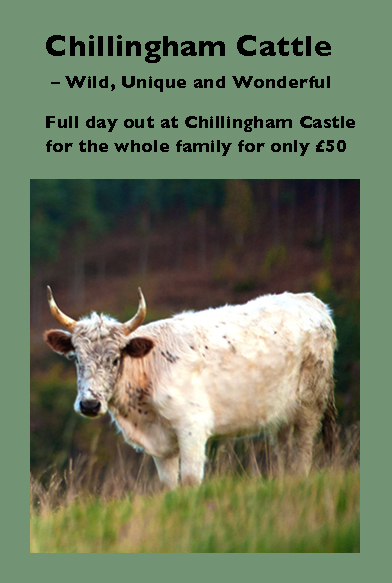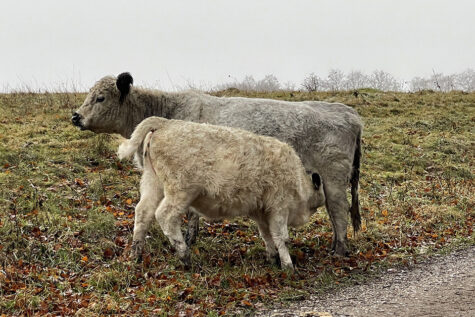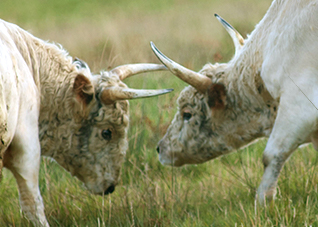Also known as the Chillingham Cattle, Britain is home to four flocks of White Cattle living in the wild since the 12th century.
 The fierce and shy wild cattle living in the park at Chillingham is but one flock of four roaming at Woburn, Dynevor, and Cadzow. Earlier on, such herds were a common feature in the British landscape, probably kept for their ornamental and symbolic value. Known in the 12th century as Tauri Sylvestres, they have apparently always been considered a wild sub-species. The herd at Chillingham, though, was first mentioned in 1645. Today, about 130 animals live in the 150-ha large park in Northumberland. The herd is protected from being earmarked, a true sign of their “wild” status.
The fierce and shy wild cattle living in the park at Chillingham is but one flock of four roaming at Woburn, Dynevor, and Cadzow. Earlier on, such herds were a common feature in the British landscape, probably kept for their ornamental and symbolic value. Known in the 12th century as Tauri Sylvestres, they have apparently always been considered a wild sub-species. The herd at Chillingham, though, was first mentioned in 1645. Today, about 130 animals live in the 150-ha large park in Northumberland. The herd is protected from being earmarked, a true sign of their “wild” status.
These flocks of wild cattle were treated as a kind of super-deer eaten on festive occasions, such as at the Archbishop of York installation feast in 1466. At the celebrations, six wild bulls were roasted and served. It appears the white cattle survived as potent medieval status symbols alongside other wild species. Evidence from Auckland Castle indicates a herd of White Cattle was kept in the 15th-century deer park for ornamental reasons together with wild horses.
From Wales, we know that white cattle were used as a coin to measure fines payable to the Lords of Dynevar. In AD 1210, a Welsh Marcher lord tried to bribe King John with a White bull and four hundred cows.
It is usually supposed that the wild cattle living in the parks are descended from free-living cattle, which is otherwise well documented. Thus we lear from Fits-Stephens description of London from 1174 (from his biography of Thomas Becket) how there to the North were “tilled fields, pastures, and pleasant, level meadows with streams flowing through them”. Not far off spread “out a vast forest, its copses dense with foliage concealing wild animals – stags, does, boars, and wild bulls.”.
However, from medieval reports we also know that herds of cattle were regularly moved from one deer park to another. In 1277 Edward I specifically ordered wild cows and bulls to be taken to Windsor Forest. Whether or not elaborate hunts were staged at the deer parks remains unknown.
Recent studies of the genetics

One of the distinguishing features of this subspecies of cattle appears to be its white coat. Studies of their DNA have shown that the colour reflects a chromosomal homozygous translocation which also causes testicular hypoplasia. Also present in the white Galloway and the Irish Moiled, it is also found in the Northern Finncattle and the Swedish Mountain breed. It has been suggested that the cattle were initially imported to The British Isles in the maelstrom of the Viking conquests.
Just as two breeds of sheep in Northwest England as well as horses and dogs have been identified as having Scandinavian roots, the scientists reporting on the genetic makeup of the Chillingham herd suggest an affinity. This, however, remains to be confirmed by further studies of the ancient Scandinavian cattle breeds.
How did the herds survive?

The survival of these herds is remarkable as the hypoplasia caused by the genetic makeup has another consequence. Accompanied by a reduced testicular functionality is poor sperm quality, which should have led to the extinction of the white herds centuries ago.
However, studies of the breeding patterns of the herds show that the Chillingham cattle breed all season, competition between the bulls is fierce, and oestrous cows are repeatedly mounted. Thus, in a study between June 1980 and December 1981, the biologists and rangers noted how 15 to 17 mature bulls carried out 71 mountings within a fortnight leading to 22 calves nine months later. Paternity to these calves could not be ascertained. Thus, the animals appear to have found a way to compensate for the genetic deficiency. It should be noted that reproductive performance is a key indicator of the long-term sustainability of any livestock production system, and that testicular hypoplasia is a morphological and functional reproductive disorder that affects bulls around the world, which might lead to aggressive breeding patterns among some semi-feral herds (for instance at Mols Lab in 2022). The incident was later villified by a group of animal activists deploring “the rape of the cows” and led to the deplorable culling of the young bulls punished for their apparently genetically sound pattern of breeding, develop to compensate for this particular genetic challenge.
This insight has significant consequences for the upkeep of this (and other herds) of these rare, semi-feral types of cattle. It would be wrong to believe that artificial fertilisation would be able to save a subspecies like the famous white cattle. Quite the opposite.
SOURCE:
Conservation of rare wild-living cattle Bos taurus (L.): coat colour gene illuminates breed history, and associated reproductive anomalies have not reduced herd fertility
S. J. G. Hall, B. Brenig, R. A. Ashdown, M. R. Curry
First published: 02 September 2021 in Journal of Zoology (2021) Vol 315, issue 4.
Aspects of archaeology, history, landscape, material culture and structures of bishop’s houses in the English dioceses of Carlisle and Durham, and the Scots dioceses of Glasgow and St. Andrews c1450-1660.
By C.E.H. Smith
Thesis, Durham 2020.
Wild White Cattle of Great Britain
By Hellidon John Storer
London 1879
Race, Breed, and Myths of Origin: Chillingham Cattle as Ancient Britons
By Harriet Ritvo
In: Representations (1992), Vol 39 pp 1 – 22
READ ALSO:
VISIT:
It is possible to go on a guided tour of the park during the summer.
Joint Cattle and Castle tickets are available via the Wild Cattle website. Numbers on the Wild Cattle tours are restricted, so it is best if you book on line so as to avoid any possible disappointment. Visit www.chillinghamwildcattle.com for more information.
Also, the 12th-century Castle of Chillingham offers tours during the summer as well as stays in the self-catering aprtments in the Coaching Rooms. Unfortunately, no pets are allowed.
